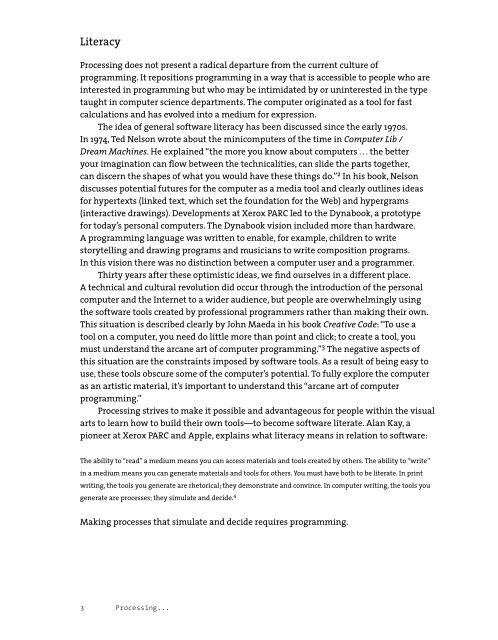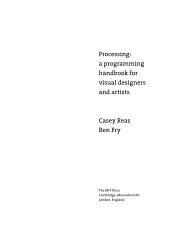Fractal.Invaders, Substrate (Interview with Jared Tarbell) - Processing
Fractal.Invaders, Substrate (Interview with Jared Tarbell) - Processing
Fractal.Invaders, Substrate (Interview with Jared Tarbell) - Processing
Create successful ePaper yourself
Turn your PDF publications into a flip-book with our unique Google optimized e-Paper software.
Literacy<br />
<strong>Processing</strong> does not present a radical departure from the current culture of<br />
programming. It repositions programming in a way that is accessible to people who are<br />
interested in programming but who may be intimidated by or uninterested in the type<br />
taught in computer science departments. The computer originated as a tool for fast<br />
calculations and has evolved into a medium for expression.<br />
The idea of general software literacy has been discussed since the early 1970s.<br />
In 1974, Ted Nelson wrote about the minicomputers of the time in Computer Lib /<br />
Dream Machines. He explained “the more you know about computers . . . the better<br />
your imagination can fl ow between the technicalities, can slide the parts together,<br />
can discern the shapes of what you would have these things do.” 2 In his book, Nelson<br />
discusses potential futures for the computer as a media tool and clearly outlines ideas<br />
for hypertexts (linked text, which set the foundation for the Web) and hypergrams<br />
(interactive drawings). Developments at Xerox PARC led to the Dynabook, a prototype<br />
for today’s personal computers. The Dynabook vision included more than hardware.<br />
A programming language was written to enable, for example, children to write<br />
storytelling and drawing programs and musicians to write composition programs.<br />
In this vision there was no distinction between a computer user and a programmer.<br />
Thirty years after these optimistic ideas, we fi nd ourselves in a different place.<br />
A technical and cultural revolution did occur through the introduction of the personal<br />
computer and the Internet to a wider audience, but people are overwhelmingly using<br />
the software tools created by professional programmers rather than making their own.<br />
This situation is described clearly by John Maeda in his book Creative Code: “To use a<br />
tool on a computer, you need do little more than point and click; to create a tool, you<br />
must understand the arcane art of computer programming.” 3 The negative aspects of<br />
this situation are the constraints imposed by software tools. As a result of being easy to<br />
use, these tools obscure some of the computer’s potential. To fully explore the computer<br />
as an artistic material, it’s important to understand this “arcane art of computer<br />
programming.”<br />
<strong>Processing</strong> strives to make it possible and advantageous for people <strong>with</strong>in the visual<br />
arts to learn how to build their own tools—to become software literate. Alan Kay, a<br />
pioneer at Xerox PARC and Apple, explains what literacy means in relation to software:<br />
The ability to “read” a medium means you can access materials and tools created by others. The ability to “write”<br />
in a medium means you can generate materials and tools for others. You must have both to be literate. In print<br />
writing, the tools you generate are rhetorical; they demonstrate and convince. In computer writing, the tools you<br />
generate are processes; they simulate and decide. 4<br />
Making processes that simulate and decide requires programming.<br />
3 <strong>Processing</strong>...



